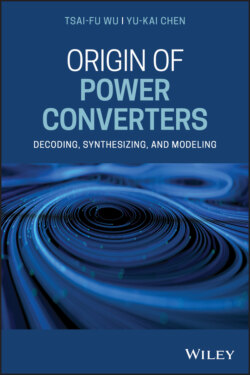Читать книгу Origin of Power Converters - Tsai-Fu Wu - Страница 30
2.1.3 Resonance Approach
ОглавлениеPower transfer between energy storage elements, capacitors and inductors, has three types of configurations, as shown in Figure 2.3. The two types shown in Figure 2.3a and b will result in electrical energy loss up to half the initially stored energy when turning on switch S1 and under the condition of capacitance C1 = C2 or inductance L1 = L2. To conserve the total electrical energy during power transfer, the only valid configuration is shown in Figure 2.3c where the power transfer is from capacitor to inductor or vice versa and it is conducted in resonant manner. Practical examples applying this configuration are shown in Figure 2.4, in which Figure 2.4a shows a current output and Figure 2.4b shows a voltage one, and the diode D1 is introduced to the converter to circulate the energy stored in inductor L1 when switch S1 turns off. With the freewheeling diode D1, the converter shown in Figure 2.4b can be controlled with PWM to tune its input‐to‐output voltage transfer gain. This converter, namely, buck converter, consists of the minimum number of components for power transfer with resonance.
Figure 2.2 Analogy of the buck converter derivation to proton–neutron–meson model of a nucleus.
Figure 2.3 Three types of configurations of power transfer between capacitors and inductors.
Figure 2.4 Practical examples applying the configuration shown in Figure 2.3c: (a) with current output and (b) with voltage output.
In the above discussions, the buck converter has been derived with different approaches. Its power transfer is straightforward from input to output when turning on active switch S1, and when turning off the switch, the energy stored in inductor L1 is continuously releasing to the output. The power flow can be controlled with PWM, and its output is always limited within the input voltage in the steady state. From dynamic point of view, the buck converter is a kind of minimum‐phase system, and it is easy to achieve high stability margin. With all of these positive natural properties together, the buck converter has the potential to be the original converter for evolving the rest of PWM converters. This viewpoint will be proved through decoding and synthesizing processes in later chapters.
